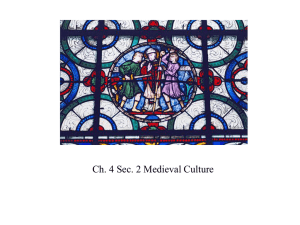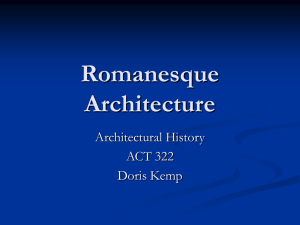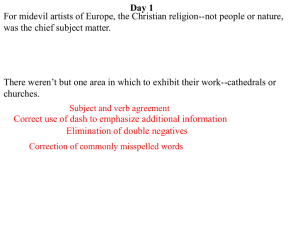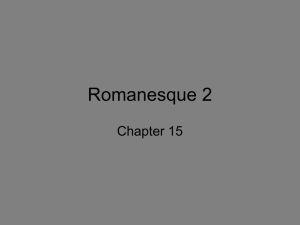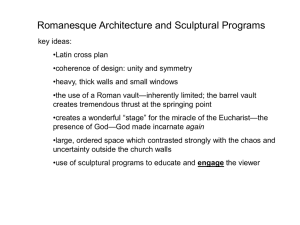PowerPoint
advertisement
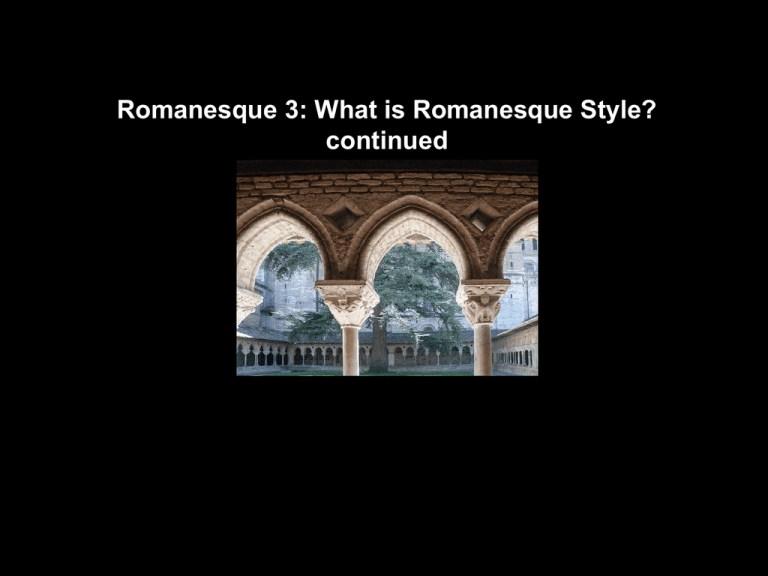
Romanesque 3: What is Romanesque Style? continued III. Romanesque Burgundy alternative thin wall construction First large-scale church in France with groin vaults throughout Benedictine Abbey at Vézelay (Cluniac 1096-1137), choir, transept, narthex, 1090-1104 nave 1120-32 nave 1120-32 III. Romanesque Burgundy alternative thin wall construction First large-scale church in France with groin vaults throughout Vézelay – groin-vaulted nave with generous clerestory windows groin or cross vaults III. Romanesque Burgundy narthex portals Vézelay – narthex with sculpted portal going into the nave coming out into the narthex III. Romanesque Burgundy narrative sculpture on portals + in cloisters Benedictine abbey at Moissac, France (Cluniac from 1048), south portal 1115-30 III. Romanesque Burgundy narrative sculpture on portals + in cloisters Earliest historiated capitals in a cloister Cloister of Moissac abbey church, 1085-1100 cloister walk cloister garden III. Romanesque Burgundy narrative sculpture on portals + in cloisters South portal of Moissac abbey church, 1115-30 trumeau – prophet Jeremiah trumeau III. Romanesque Burgundy: the Cistercian challenge 1073 Benedictine monk Robert of Molesme joins hermits in the forest of Collan 1098 Robert, Alberic, and Stephen Harding settle in the forest of Cîteau, found the New Monastery III. Romanesque Burgundy: Cistercian challenge Cîteaux = Cisteaux = Cistercian What remains of the abbey at Cîteaux 1113 Nobleman Bernard of Fontaine (a.k.a. Bernard of Clairvaux) arrives at Cîteaux Bernard: “One learns more in the woods than in books. The trees and the rocks will teach you things you will not hear elsewhere.” III. Romanesque Burgundy: Cistercian challenge Bernard founds the new of daughter house of the monks at Ciairvaux in 1115 and Fontenay in 1118 Fontenay Abbey, France, construction 1133-47 Clairvaux today III. Romanesque Burgundy: Cistercian challenge Fontenay Abbey III. Romanesque Burgundy: Cistercian challenge Work ethos = functional buildings cloister(s), refectory, chapter house, dormitory, workroom and forge, fountain Benedictine abbey at Cluny Cistercian abbey of Fontenay III. Romanesque Burgundy: Cistercian challenge Work ethos = functional buildings Fontenay forge dormitory Distinctive formal characteristics of the Romanesque Cistercian abbey of Fontenay clear geometric shapes (massing) ? Distinctive formal characteristics of the Romanesque exterior/interior masses and volumes correspond Cistercian abbey church of Fontenay east end facing east toward chancel Distinctive formal characteristics of the Romanesque exterior/interior masses and volumes correspond Cistercian abbey church of Fontenay transept with chancel and chapels east end III. Romanesque Burgundy: Theory Plan of a Cistercian church from French master-builder Villard de Honnecourt’s sketchbook (1230s) the Cistercian model Cistercian abbey of Fontenay III. Romanesque Burgundy: Theory Cistercian abbey church of Fontenay the Cistercian model III. Romanesque Burgundy: Cistercian challenge the cloister Fontenay’s cloister cloister walk cloister garden Le Thoronet Cistercian abbey, France (Provence), 1135 Le Thoronet Cistercian abbey, France (Provence), 1135 III. Romanesque Burgundy: the Cistercian challenge Network of Cluniac monasteries Network of Cistercian monasteries IV. Romanesque basilicas and structure – looking up (wall to ceiling) St. Michael’s, Hildesheim, Germany, 1010-33 (Ottonian) Implications for articulation of wall and parts? Speyer Cathedral, Germany, 1030-61; 1081-1133 IV. Romanesque basilicas – looking up (wall to ceiling) St. Michael’s, Hildesheim, Germany, 1010-33 (Ottonian) Implications for articulation of wall and parts? Speyer Cathedral, Germany, 1030-61 (wood ceiling) IV. Romanesque basilicas – looking up (wall to ceiling) Central Italy (Tuscany) – wood ceiling Pisa Cathedral, 1063-1118 Implications for articulation of wall and parts? Germany (wood ceiling) Speyer Cathedral, 1030-61 IV. Romanesque basilicas – looking up (wall to ceiling) wood ceilings IV. Romanesque basilicas – looking up (wall to ceiling) Germany Normandy: implications for wall and parts? Normandy Abbey church at Jumièges (Normandy) France, 1037-66, wood roofed nave Speyer Cathedral, 1030-61 IV. Romanesque basilicas with wood roofs Normandy: implications for wall and parts? Germany Normandy wood roof and double bays Speyer Cathedral, 1030-61 Jumièges (Normandy) France, 1037-66 IV. Romanesque basilicas – looking up (wall to ceiling) Germany groin vaulted nave and double bays Speyer Cathedral, 1081-1133 Germany’s vaults: implications for wall and parts? Normandy wood roof and double bays Jumièges (Normandy) France, 1037-66 IV. Romanesque basilicas – looking up (wall to ceiling) Normandy: implications for wall and parts? Abbey of St.-Étienne, Caen, France, 11th-12th century (1064-77, vaults 1120) IV. Romanesque basilicas – looking up (wall to ceiling) Normandy: wood ceiling and thick wall construction St.-Étienne at Caen with timber ceiling, double bays, and clerestory passage, 1064-77 IV. Romanesque basilicas – looking up (wall to ceiling) Anglo-Norman wood ceiling Ely Cathedral, 1081-115 England: wood ceiling and thick wall construction Germany (wood ceiling) Speyer Cathedral, 1030-61 IV. Romanesque basilicas and structure rib vaults Durham’s choir aisle vaults, earliest known rib vaults, 1093 Durham Cathedral, Durham, England, 1093-1133 rib vaults in choir aisle (1093-96) skeletal frame alone bears the load IV. Romanesque basilicas and structure rib vaults Durham Cathedral – rib vaults in choir aisle skeletal frame alone bears the load IV. Romanesque basilicas and structure planking and wattle to support webbing duringone construction mobile centering bay at a time rib vaults ribs of a rib vault Soissons Cathedral, France left in place in Lincoln Cathedral IV. Romanesque basilicas and structure Durham Cathedral, Durham, England, 1093-1133 regular clergy (monastic clergy) = monastic layout about Durham IV. Romanesque basilicas – looking up (wall to ceiling) Durham: rib vaults, thick wall, double bay Durham Cathedral – thick wall and double bay system IV. Romanesque basilicas – looking up (wall to ceiling) Earls Barton, 970 - Anglo-Saxon church tower with linear surface decoration Durham: rib vaults, thick wall, double bay Durham Cathedral – surface decoration on archivolts and cylindrical piers IV. Romanesque basilicas and structure rib vaults Durham nave rib vaults, 1128-33 IV. Romanesque basilicas and structure St.-Étienne with timber ceiling, 1064-77 rib vaults St.-Étienne with rib vaults added 1120 IV. Romanesque basilicas – looking up (wall to ceiling) Normandy: rib vaults, thick wall, double bay St.-Étienne with rib vaults added 1120 – thick-wall, double-bay system IV. Romanesque basilicas – looking up (wall to ceiling) Speyer Cathedral (Rhineland, Germany) with groin vaults and double-bay system Different vaults and double bay systems St.-Étienne at Caen (Normandy) with sexpartite rib vaults and double-bay system IV. Romanesque basilicas – looking up (wall to ceiling) S. Ambrogio in Milan with quadripartite rib vaults on double-bay system, complete by 1117 Other rib vaults and double bay systems St.-Étienne in Caen with rib vaults added in 1120 IV. Romanesque basilicas and structure St.-Étienne with sexpartite rib vaults and all round arches Durham: first pointed rib Durham Cathedral with paired quadripartite rib vaults and pointed transverse arches IV. Romanesque basilicas and structure Durham: first pointed rib Pointed arches and vaults – already seen in Burgundy (Cluny III) but not combined with rib technique Cluny III: load-bearing pointed barrel vault with pointed transverse arches Durham: pointed rib (the transverse arches only) V. Romanesque structural technology building blocks of Gothic architecture available Gothic architecture + Roger Stalley, Early Medieval Architecture, 1999
